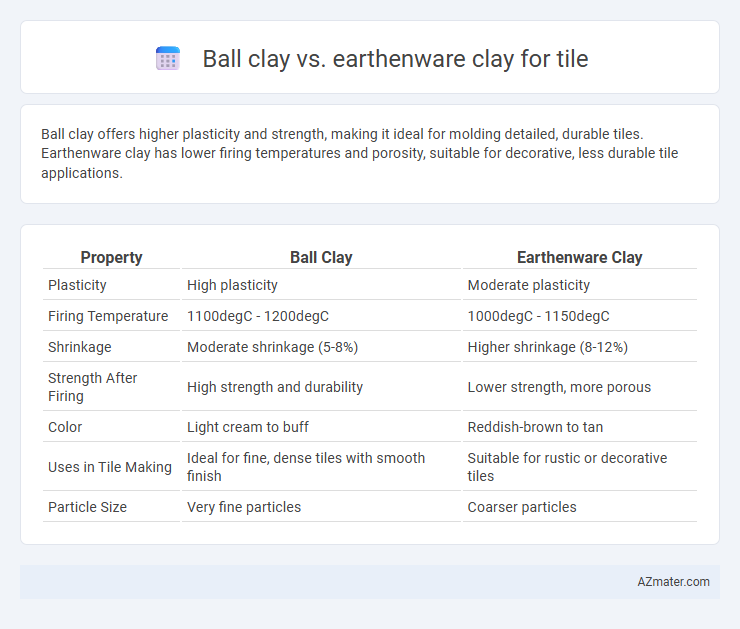Ball clay offers higher plasticity and strength, making it ideal for molding detailed, durable tiles. Earthenware clay has lower firing temperatures and porosity, suitable for decorative, less durable tile applications.
Table of Comparison
| Property | Ball Clay | Earthenware Clay |
|---|---|---|
| Plasticity | High plasticity | Moderate plasticity |
| Firing Temperature | 1100degC - 1200degC | 1000degC - 1150degC |
| Shrinkage | Moderate shrinkage (5-8%) | Higher shrinkage (8-12%) |
| Strength After Firing | High strength and durability | Lower strength, more porous |
| Color | Light cream to buff | Reddish-brown to tan |
| Uses in Tile Making | Ideal for fine, dense tiles with smooth finish | Suitable for rustic or decorative tiles |
| Particle Size | Very fine particles | Coarser particles |
Understanding Ball Clay and Earthenware Clay
Ball clay is a highly plastic, fine-grained sedimentary clay rich in kaolinite, commonly used to increase the strength and workability of ceramic bodies. Earthenware clay, composed primarily of iron and other oxides, is less plastic and fires at lower temperatures, producing porous and colorful tiles ideal for decorative and functional applications. Understanding the specific properties of ball clay, such as its plasticity and particle size, and earthenware clay, including its firing temperature and porosity, is essential for selecting the right material in tile production.
Key Differences in Composition
Ball clay contains a higher percentage of kaolinite and organic matter, resulting in greater plasticity and strength compared to earthenware clay. Earthenware clay generally has more iron and other impurities, giving it a coarser texture and a lower firing temperature. These compositional differences affect the tile's durability, porosity, and finish quality, with ball clay producing finer, stronger tiles.
Physical Properties Comparison
Ball clay exhibits higher plasticity and finer particle size compared to earthenware clay, resulting in better moldability and surface smoothness for tile production. Earthenware clay contains higher levels of iron and alkali oxides, giving it greater porosity and lower firing temperature than ball clay, which enhances water absorption but reduces durability. The denser structure of ball clay yields stronger, less porous tiles ideal for high-traffic areas, whereas earthenware tiles are more suited for decorative or low-impact applications due to their softer texture.
Workability and Plasticity
Ball clay exhibits superior plasticity and workability compared to earthenware clay, making it ideal for intricate tile shaping and molding. Its fine particle size and high clay content provide excellent flexibility and smoothness during the forming process. Earthenware clay, while workable, tends to be coarser and less plastic, resulting in reduced ease of manipulation for detailed tile designs.
Firing Temperatures and Results
Ball clay typically fires at cone 04 to cone 6 (approximately 1940degF to 2230degF), producing a strong, plastic, and smooth texture ideal for tile bodies requiring high plasticity and strength. Earthenware clay fires at lower temperatures, around cone 06 to cone 1 (about 1828degF to 2167degF), resulting in porous, softer tiles that often need glaze sealing for durability. The higher firing temperature of ball clay contributes to enhanced vitrification and durability, whereas earthenware clay's lower firing temperature limits tile strength but offers easier workability and a warmer color palette.
Color and Appearance After Firing
Ball clay typically produces a smoother, more uniform surface with a creamy or off-white color after firing, making it ideal for achieving a refined, polished look in tiles. Earthenware clay tends to result in warmer, earth-toned colors such as reds, browns, and oranges due to its higher iron content, which enhances a rustic and natural aesthetic. The choice between ball clay and earthenware clay significantly influences the visual texture and color saturation of the finished tile.
Durability and Longevity in Tiles
Ball clay offers increased plasticity and workability, making it ideal for intricate tile designs, but it generally results in lower durability compared to earthenware clay due to its higher particle fineness and porosity. Earthenware clay, with its denser composition and higher firing temperature, produces tiles that exhibit superior strength and longevity, resisting cracking and wear over time. For tiles requiring extended durability and lifespan, earthenware clay is the preferred choice due to its enhanced structural integrity.
Suitability for Different Tile Applications
Ball clay offers high plasticity and fine particle size, making it ideal for intricate tile designs requiring detailed molding and smooth finishes. Earthenware clay, with its lower firing temperature and coarser texture, suits rustic or decorative tiles used in low-traffic areas or artistic applications. For durable, high-strength tiles in flooring or heavy-use environments, ball clay combined with other clays enhances strength and vitrification.
Pros and Cons of Ball Clay vs Earthenware Clay
Ball clay offers superior plasticity and strength, making it ideal for producing durable, finely detailed tiles, but it can be prone to warping during drying due to its high shrinkage rate. Earthenware clay is easier to work with and fires at lower temperatures, resulting in porous yet aesthetically versatile tiles, though these tiles are less durable and more susceptible to chipping and moisture absorption. Choosing between ball clay and earthenware clay depends on the desired tile strength, firing temperature, and finish quality requirements.
Choosing the Right Clay for Your Tile Project
Ball clay offers high plasticity and fine particle size, making it ideal for detailed tile molding and smooth surface finishes. Earthenware clay, with its lower firing temperature and porous nature, provides a rustic appearance but requires careful sealing to prevent water absorption. Selecting the right clay depends on your tile project's durability needs, aesthetics, and firing capabilities.

Infographic: Ball clay vs Earthenware clay for Tile
 azmater.com
azmater.com